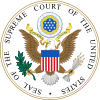Hurd v. Hodge
| Hurd v. Hodge | |
|---|---|
 | |
| Argued January 15–16, 1948 Decided May 3, 1948 | |
| Full case name | Hurd et al. v. Hodge et al., Urciolo et al. v. Same |
| Citations | 334 U.S. 24 (more) 68 S. Ct. 847; 92 L. Ed. 2d 1187 |
| Holding | |
| The Fourteenth Amendment prohibits a federal court from enforcing restrictive covenants that would prohibit a person from owning or occupying property based on race or color. | |
| Court membership | |
| |
| Case opinions | |
| Majority | Vinson, joined by Black, Douglas, Murphy, Burton |
| Concurrence | Frankfurter |
| Reed, Jackson and Rutledge took no part in the consideration or decision of the case. | |
Hurd v. Hodge, 334 U.S. 24 (1948), was a companion case to Shelley v. Kraemer, in which the Court held that the Fourteenth Amendment prohibits a federal court from enforcing restrictive covenants that would prohibit a person from owning or occupying property based on race or color. Hurd v. Hodge also involved racially restrictive covenants on houses in the Bloomingdale neighborhood of Washington, D.C.[1]
However, the Equal Protection Clause does not explicitly apply to a U.S. territory not in a U.S. state, and so the decision varied from the Fourteenth Amendment ruling in Shelley v. Kraemer. In Hurd, the Court found against the segregationists by holding that both the Civil Rights Act of 1866 and treating persons in the District of Columbia like those in the states would forbid restrictive covenants.[2]
See also
- List of United States Supreme Court cases, volume 334
- Shelley v. Kraemer (1948), a companion case to Hurd v. Hodge
References
External links
 Works related to Hurd v. Hodge at Wikisource
Works related to Hurd v. Hodge at Wikisource- Text of Hurd v. Hodge, 334 U.S. 24 (1948) is available from: Cornell CourtListener Findlaw Google Scholar Justia Library of Congress
- v
- t
- e
 | This civil rights movement–related article is a stub. You can help Wikipedia by expanding it. |
- v
- t
- e












